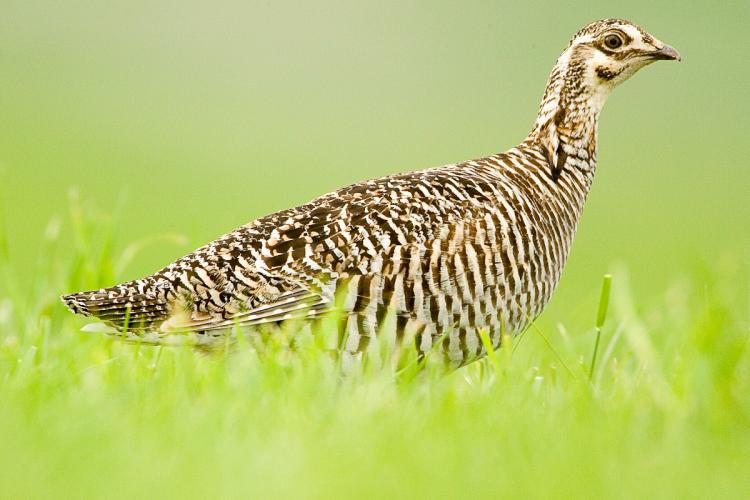
Xplor reconnects kids to nature and helps them find adventure in their own backyard. Free to residents of Missouri.


































Stay in Touch with MDC news, newsletters, events, and manage your subscription

Xplor reconnects kids to nature and helps them find adventure in their own backyard. Free to residents of Missouri.

A monthly publication about conservation in Missouri. Started in 1938, the printed magazine is free to residents of Missouri.


Kansas City, Mo. – Hard rains and cool conditions in early summer are not optimal conditions for Missouri's endangered prairie chickens to nest and raise broods. Unusually wet weather befell western Missouri this nesting season. What's good for many native prairie grasses and wildflowers can be a hindrance to ground-nesting birds. But Missouri Department of Conservation (MDC) biologists are hopeful that habitat improvements in recent years will help the iconic grassland grouse hold their numbers steady.
Biologists have spotted some hens with young broods at Dunn Ranch and the Pawnee Prairie Conservation Area in Harrison County in northwest Missouri. The Nature Conservancy's Dunn Ranch and MDC's Pawnee Prairie are at the heart of a broad conservation focus area called the Grand River Grasslands.
Given the weather, finding successful broods is encouraging and signals that the nesting season was not a bust, said MDC Wildlife Management Biologist Dave Hoover.
"Habitat conditions on public and private lands have improved in the last five years," Hoover said. "More of the core conservation area lands are in better habitat for grassland birds. That has probably allowed prairie chickens to handle the adverse weather conditions better than in previous years."
Missouri once had hundreds of thousands of prairie chickens on vast open grasslands and areas with a mix of scattered trees and prairie plants. Today, because of prairie habitat loss, less than 100 prairie chickens remain in two main flocks, plus a few scattered birds in areas that once had flocks. That number includes prairie chickens netted and translocated from Kansas and Nebraska to Missouri in restoration efforts.
MDC biologists counted 40 prairie chickens on five different leks, or mating grounds, this spring on the Missouri side of the Grand River Grasslands. Part of the cooperative grassland effort is in adjacent Iowa. Also this spring, biologists released at Dunn Ranch 19 males and 20 female prairie chickens translocated from Nebraska. The 20 hens were given small radio collars, which assists biologists tracking birds to find nests and broods.
Tracking prairie chickens with radio telemetry has helped biologists learn about the different types of habitat useful for prairie chickens and other ground nesting birds. They need grassy areas of boot-high vegetation for nesting in spring and areas of boot- to knee-high vegetation for brood rearing in late spring and summer. Hens with broods prefer a mixture of grasses and wildflowers that are open at ground level so chicks can move easily. Prairie chickens also favor feeding and loafing in these same areas where they can easily survey their surroundings but also duck into cover if predators appear.
Biologists do not have radio collars on prairie chickens this year in the Upper Osage Grasslands in southwest Missouri. But they have used radio telemetry in past years to monitor hens translocated from Kansas to the Wah'Kon-Tah Prairie and the MDC's Taberville Prairie Conservation Area, both north of El Dorado Springs. The flocks appear to be holding steady at about 50 birds in that area based on spring lek surveys, said MDC Grassland Coordinator Max Alleger.
"We've kept our habitat in good shape," Alleger said. "Our crew does a stellar job of prairie management. We feel like the translocation project successfully stabilized our population there."
Biologists won't know how well prairie chickens have reproduced at Wah'Kon-Tah in a rainy summer until birds are counted on leks next spring. Predators and winter conditions also affect population numbers.
In spring and early summer, the cold and wet conditions are a threat to newly hatched prairie chickens because they cannot self-regulate their body temperatures, said MDC Resource Scientist Tom Thompson. Also, some nest sites may be in low areas that flood. Bobwhite quail may attempt two or even three nests during summer, which helps hedge against chick mortality. But prairie chicken hens usually only go on nest once.
"Prairie chickens are susceptible to everything, and everything eats them," Thompson said.
Conservation partnerships, especially with private landowners, have benefitted prairie chickens in the Grand River Grasslands and Upper Osage Grasslands. MDC offers private lands expertise and can connect property managers with cost share grants for practices that benefit livestock, water quality and wildlife.
For information about prairie chickens on your property, visit http://on.mo.gov/1IqKVP8. That web page will also link to other information about prairie chickens in Missouri.
Property owners in the Grand River Grasslands area seeking information about MDC programs can call 660-726-3746. For MDC assistance in the Upper Osage Grasslands, call 417-876-5792.
A rainy summer is not all bad for grassland birds. The grasses and wildflowers that provide food and shelter for birds are having a banner year. Although growth that's too dense inhibits movement by birds that feed and roost on the ground. Tools such as grazing, timely haying and prescribed burns can help manage grasslands to the benefit of birds and cattle. Grasslands birds have needed help from good habitat this summer.
"In one period in May and June, out of 38 days 35 saw some rainfall," Thompson said. "That's where it gets really tough for ground-nesting birds to pull off broods."